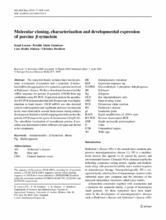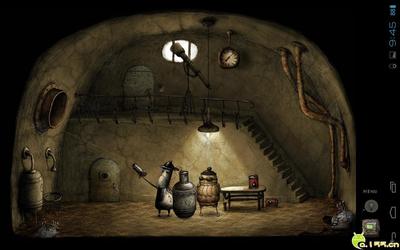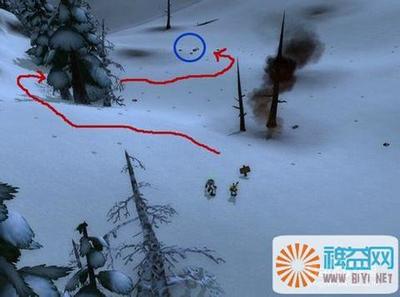PlantMolBiolRep(2013)31:547–557DOI10.1007/s11105-012-0523-6
ORIGINALPAPER
MolecularCloning,BiochemicalCharacterization,andDifferentialExpressionofanAcetyl-CoAC-AcetyltransferaseGene(AACT)ofBrahmi(Bacopamonniera)
RishiK.Vishwakarma&Ruby&SomeshSingh&PrashantD.Sonawane&SameerSrivastava&
UmaKumari&R.J.SantoshKumar&BashirM.Khan
Published#online:21November2012
SpringerScience+BusinessMediaNewYork2012
AbstractBacopamonniera(Brahmi)isanimportantIndianmedicinalherbfoundinwetdampandmarshyplaces.Itproducesmedicinallyimportantcompoundsknownasbaco-sidesalongwithalkaloidslikebrahmineandherpestine.Bacosidesaretriterpenoidsaponinsandtheirbiosynthesistakesplaceviatheisoprenoidpathwaystartingwithacetyl-CoA.Acetyl-CoAC-acetyltransferase(AACT;EC2.3.1.9),alsoknownasacetoacetyl-CoAthiolase(ThiolaseII),cata-lyzesthecondensationoftwoacetyl-CoAtoform4-Ccom-poundacetoacetyl-CoA.Acetoacetyl-CoAisanimportantstartingmoleculeforbiosynthesisofvariousmetabolites.Here,wereportthecDNAcloningandcharacterizationofacetyl-CoAC-acetyltransferasegenefromB.monniera.Thefull-lengthgenewasisolatedusingaRACEPCRprotocol.ThecDNAencodingAACTwasdesignatedasBmAACT(FJ947159)revealedanORFof1,218bpand405aminoacids,andshares80%similaritywithotherplantAACTs.PhylogeneticanalysisshowedthatBmAACTisrelatedclose-lytootherdicotplantsAACTs.TheBmAACTgenewasover-expressedinEscherichiacoliasa6XHis-tagfusionproteinandpurifiedtohomogeneitybyNi-NTAandgelfiltrationchromatography.Activityofrecombinantproteinwascon-firmedbythiolyticcleavageofacetoacetyl-CoAinthepres-enceof5mMMg2+,showingKmandVmaxof20.67μMand96.21μmol/min,respectively,1withhighcatalyticefficiency(kcat02.30×105min?).Quantitativereal-timePCRanalysisshowedthattheexpressionofBmAACTistissue-specific,and
R.K.VishwakarmaRubyS.SinghP.D.SonawaneS.Srivastava:U.Kumari:R.J.SantoshKumar:B.M.Khan(*)PlantTissueCultureDivision,NationalChemicalLaboratory,Dr.HomiBhabhaRoad,
Pune411008Maharashtra,Indiae-mail:bm.khan@ncl.res.in
accumulationoftranscriptsisgreaterinrootsandpetals,followedbysepals,stem,leafandpedicel.
KeywordsAcetyl-CoAC-acetyltransferase.Bacopamonniera.Isoprenoidpathway.TriterpenoidsaponinAbbreviationsAMV-RTAvianmyeloblastosisvirus
reversetranscriptase
cDNAComplementaryDNAAACTAcetyl-CoAC-acetyltransferaseBmAACTBacopamonnieraAcetyl-CoA
C-acetyltransferasegene
BMEβ-MercaptoethanolRACERapidamplificationofcDNAendsqRT-PCRQuantitativereal-timePCRIPTGIsopropylβ-D-thiogalactopyranosideSDS-PAGESodiumdodecylsulfate
polyacrylamidegelelectrophoresis
UTRUntranslatedregion
Introduction
Thiolasesplayanimportantroleinmanybiochemicalprocess-es,includingisoprenopid,steroidandalkaloidbiosynthesisaswellasβ-oxidationoffattyacids.Isoprenoids,alsoreferredtoasterpenoids,representavastgroupofnaturalproductswithvarietyoffunctionsintheprimaryandsecondarymetabolismofplants(Langeetal.2000).AllisoprenoidsaresynthesizedfromtwouniversalC5compoundsknownasisopentenyldi-phosphate(IPP)anditsisomerdimethylallyldiphosphate(DMAPP)(KirbyandKeasling2009).BiosynthesisofIPPtakesplaceviaeitheroftwopathways:themevalonate
548(MVA)pathwayorthenon-mevalonate/methylerythritolphos-phate(MEP)pathway(Langeetal.2000;Setoetal.1996).TheMVApathwayoperatesinthecytosolwhereastheMEPpath-wayexistsinplastidsandisconnectedthroughIPPexchangeacrossthechloroplastmembrane(Lauleetal.2003).However,nativecross-talkbetweentheMVAandMEPpathwaysisstillunclear(Suzukietal.2009).
TheMVApathwaystartswiththetwo-carboncompoundacetylCoA,whichcondensesintothe4-Ccompoundacetoacetyl-CoAcatalyzedbyacetyl-CoAacetyltransferase(AACT).Acetyl-CoAacetyltransferase(AACT)orthiolasesareclassifiedintotwotypes,degradativethiolases(E.C.2.3.1.16)andbiosyntheticthiolases(E.C.2.1.1.9)(ModisandWierenga2000).Thedegradativethiolasesareinvolvedinβ-oxidationoffattyacids(JenkinsandNunn1987),where-asthebiosyntheticthiolasescatalyzethecondensationoftwoacetyl-CoAmoleculestoformacetoacetyl-CoA.Igualetal.(1992)reportedthatacetoacetyl-CoAisanimportantstartingmoleculeinhormoneandcholesterolbiosynthesis.Inprokar-yotes,AACTcatalyzesthefirststepofpolyhydroxybutyrate(PHB)biosynthesisviathethiolaseIIpathway(SteinbuchelandHein2001).IntheMVApathway,theenzyme3-hydroxy-3-methyl-glutaryl-CoAreductase(HMGR)catalyzesthecon-versionofHMG-CoAtomevalonateandhasbeendescribedastherate-limitingstep(BuhaescuandIzzedine2007;Hunter2007).KirbyandKeasling(2009)suggestedthatHMGRactivityispost-transcriptionallyandpost-translationallyregu-latedinplants.Interestingly,thecondensationreactionofthiolasefromeukaryoteshasnotbeenrecognizedasanim-portantregulatorypointinbiosyntheticprocesses;however,itwasprovedrecentlythatAACTisaregulatoryenzymeinisoprenoidbiosynthesisandisinvolvedinabioticstressadap-tationinalfalfa(Sotoetal.2011).
ThiolasegeneshavebeenstudiedinvariousorganismsincludingClostridium(MengandLi2006),Rhizobium(KimandCopeland1997),Dictyostelium(Tanakaetal.2010),radish(VollackandBach1996),Arabidopsis(Carrieetal.2007;Ahumadaetal.2008),sunflower(Oeljeklausetal.2002;Dyeretal.2009),andHeveabrasiliensis(Sandoetal.2008).However,littleisknownabouttheroleofthisenzymeinisoprenoidbiosynthesisinplants(VollackandBach1996;Bachetal.1999).Sandoetal.(2008)functionallycharacter-izedH.brasiliensisAACT(HbAACT1)inayeastheterolo-goussystem,andreportedthatheterozygousyeastlackedanalleleofthethiolaseIIgeneinvolvedintheMVApathway.Moreover,itwasalsofoundthatexpressionofHbAACT1promotedyeastgrowthonnonselectionmedium.Recently,theAACTgenefromsunflowercotyledonswascloned,andarecombinantenzymeofspecificactivityof63nkat/mgproteinwaspurified(Dyeretal.2009).Inarecentstudy,MedicagosativathiolaseII(MsAACT1)wasover-expressedinplanta,andtransgenicplantsexhibitedsalinitytoleranceanden-hancedproductionofsqualenewithoutalteringHMGR
PlantMolBiolRep(2013)31:547–557
activityundersaltstressconditions(Sotoetal.2011).Inotherstudies,thenumberofgenesassociatedwithsaltstressresponsesinrootsofRhizophorastylosa(Basyunietal.2011)andHibiscus(Yangetal.2011)havebeendetermined.TransgenicArabidopsisandtobaccoplantsover-expressingglycogensynthasekinaseaswellaslateembryogenesisabun-dant(LEA)andbasicleucinezipper(bZIP)genesshowedenhancedtolerancetosaltandosmoticstresses(Heetal.2012;Quetal.2012).
Inthisstudy,ageneencodingthiolasewasisolated,clonedandcharacterizedfromthemedicinalherbBacopamonniera(Brahmi).ItisanimportantAyurvedicmedicineusedasabraintonic,memoryenhancer,revitaliserofsensoryorgans,diureticandcardio-tonic(SivarajanandBalchandran1994;Chopraetal.1969).Themainactiveconstituentsofthisplantaretriter-penoidsaponinscalledbacosides;differentformsofbacosideshavebeenidentified(Chakravartyetal.2001;Rastogietal.1994;Chatterjeeetal.1963).Theyaresynthesizedfromacetyl-CoAmoleculeviatheMVApathway.Recently,itwasreportedthatAACTisregulatoryenzymeintheisoprenoidpathwayundersaltstressconditionsandenhancestheproduc-tionofsqualene(Sotoetal.2011).Therefore,studyingtheAACTgenecouldhavegreatbiotechnologicalimportance.Over-expressionofthisgeneinBacopacouldhelpabioticstresstolerance.Thetransgenicplantsdevelopedwouldhaveimprovedsqualenecontent,ultimatelyleadingtoformationofvarioustriterpenoids,andneedstobefurtherstudiedinplanta.
MaterialsandMethodsPlantMaterial
TheaerialpartofB.monnieragrowninagreenhousemaintainedattheNationalChemicalLaboratory(NCL)wasusedforisolationoftheBmAACTgene.Quantitativereal-timePCR(qRT-PCR)wasperformedusingstem,leaf,root,sepal,pedicelandpetaloffield-grownplants.TotalRNAIsolationandFirst-StrandcDNASynthesisAerialpartsofB.monnieraplantsamplesweregroundinliquidnitrogentoafinepowderusingamortarandpestle.TotalRNAwasextractedfromapproximately100mgtissueusingTRIzol-Reagent(Invitrogen,Carlsbad,CA)asperthemanufacturer’sinstructions.ThequantityandqualityofisolatedRNAwascheckedat260nmand280nmwithUV-Visiblespectropho-tometer(NanoVueplus,GEHealthcare,Uppsala,Sweden)andRNAwasstoredinDEPC-waterat?80°Cforfutureuse.First-strandcDNAsynthesiswasperformedbyreversetranscriptionPCRwithtotalRNA(1μg)andoligo(dT)18asprimerusingavianmyeloblastosisvirusreversetranscriptase(AMV-RT;Promega,Madison,WI),accordingtothemanufacturer’s
PlantMolBiolRep(2013)31:547–557549
protocol.ForqRT-PCR,totalRNAwasisolatedfromdifferenttissuesandfirststrandcDNAwassynthesizedasabove.IsolationofPartialcDNAFragmentofBmAACTGeneApartialfragmentoftheBmAACTgenewasisolatedbyaPCR-basedapproach,usingcDNAasatemplate.TheAACTsequencesfromNCBIGenBankwerealignedusingtheClustalWprogramandprimersweredesignedfromconservedregions.Sixdifferentprimersweredesigned,namelycATF1,cATF2,cATF3,cATR1,cATR2andcATR3(Table1).PCRamplificationwascarriedoutusingdifferentcombinationsofprimersetsandelecrophoreticseparationwasdoneforamplifiedPCRproductson1%agarosegel.TheamplifiedproductwaspurifiedandclonedinpGEM-TeasyPCRcloningvector(Promega).AftertransformationinEscherichiacoli(XL-10Gold)competentcells,plasmidswereisolatedfrompositiveclonesandsequenced.
IsolationandCloningofFull-LengthBmAACTcDNAbyRACEPCR
Thefull-lengthcDNAsequenceofBmAACTwasisolatedby5′and3′RACEPCR.Gene-specificforwardandreverseprimersweredesignedfromknownpartialsequenceof
Table1Primersusedforthestudy
Serialno.1.2345678910111213141516171819
a
B.monniera.For5′and3′RACE,tworoundsofPCRwereperformedusinggene-specificprimerpairsRACEATBMR1andRACEATBMNestedR1,andRACEATBMF1andRACEATBMNestedF1,respectively,alongwithprimerssuppliedinkit(Table1).SMARTRACEcDNAamplifica-tionkit(Clontech,PaloAlto,CA)wasusedfor5′RACEandfor3′RACE,GeneRacerkit(Invitrogen)wasused.ThePCRproductsobtainedwereclonedinpGEM-Teasyvectorandsequenced.Thesequenceinformationof5′and3′RACEPCRproductcloneswasusedfordesigningofprimersATBMFullF1andATBMFullR1fromthestartandstopcodon(Table1)toobtainthefull-lengthgene.PCRwasperformedwithpfxTaqDNApolymerase(Invitrogen)usingcDNAasatemplate.Thefull-lengthampliconwasclonedinpGEM-Teasyvectorandsequenced.
BioinformaticsandEvolutionaryRelatednessAnalysisTheobtainedBmAACTsequenceswereanalyzedusingonlinebioinformaticstools(http://www.ncbi.nlm.nih.gov).Thede-ductionoftheaminoacidsequences,calculationofthetheo-reticalmolecularmassandpIwereperformedwithExPASyProteomictools(http://www.expasy.ch/tools/).Globalalign-mentoftwonucleotideoraminoacidsequences,andpercent-ageofidentitywerecalculatedusingtheEMBOSSPairwiseAlignmentAlgorithms(http://www.ebi.ac.uk/emboss/).
Primersequences(5′→3′)b
CTCGAGATGTTTGTGTTGTGGAGATGTTTGYRTTGTGGGWGTAAGAGAGCMATGTTGATCCGCWCCTCCTCCTCCGTTGCAGCTTTWGGWATAGCAAGAGCGCWGCYGCACCATCACTTATGCTGCCACCACAACATCATTGATTCCCACCTGTCCCAAGTTTGCACTTAGCAGTTGCCCGGACACCTATGGGA
GCTATTGAGAGTGCTCTTAAGAGAGCAATGGCTCCAGCAGCAGCAGCG
TTAGACAAGCTCCACAACGAGAGCCGCATATGGCTCCAGCAGCAGCAGCG
CTCGAGGACAAGCTCCACAACGAGAGCGCACGCGCGCTACACCGAAGGTCTGTACAAAGGGCAGGGACGGACTACGGCATGGGAGTTTGATTCCACGCTCAAAACTTTGG
CTAATACGACTCACTATAGGGCAAGCAGTGGTATCAACGCAGAGT
AAGCAGTGGTATCAACGCAGAGTGCTGTCAACGATACGCTACGTAACGCGCTATGTAACGGCATGACAGTG
PrimernamecATF1cATF2cATF3cATR1cATR2cATR3
5′RACEATBM5′RACEATBM3′RACEATBM3′RACEATBMATBMFullF1
R1
NestedR1F1
NestedF1
ATBMFullR1pETATBMF1pETATBMR1
18SF(18SrRNA)a
18SR(18SrRNA)qAACTFqAACTR
UniversalprimerAMix(UPM)NestedUniversalprimerA(NUP)GeneRacer3′primer(3′GRP)
GeneRacer3′nestedprimer(3′NGRP)
a
GenBankaccession.No.JN148054
W0AorT,S0GorC,N0AorTorGorC,Y0TorC,R0AorG,M0AorC
b
202122
550MultiplesequencealignmentsofvariousplantAACTswerecarriedoutwithClustalW1.8(http://www.ebi.ac.uk/clustalw/).ConserveddomainsinBmAACTweredetectedusingConservedDomainDatabasesearchtool(CDD)onNCBIserver(http://www.ncbi.nlm.nih.gov/structure/cdd/wrpsb.cgi).ForevolutionaryrelatednesswithotherplantAACTs,aphylogenetictreewasbuilt.TheknowndeducedaminoacidAACTsequenceswereretrievedfromGenBankdatabaseandalignedwithMEGA4.0(Tamuraetal.2007).PhylogenetictreewasconstructedbyaNeighbor-Joiningmethod(SaitouandNei1987).Thepercentageofreplicatetreesinwhichtheassociatedtaxaclusteredtogetherinthebootstraptest(500replicates)isshownnexttothebranches(Felsenstein1985).TheevolutionarydistanceswerecomputedusingthePoissoncorrectionmethod(ZuckerkandlandPauling1965)andareintheunitsofthenumberofaminoacidsubstitutionspersite.TheAACTsequencesfromprokaryotesweretakenasanoutgroup.ExpressionofBmAACTinE.coliandPurificationofRecombinantProtein
ApairofprimerspETATBMF1andpETATBMR1(Table1)wasdesignedforcloningofBmAACTintoanexpressionvector,andthecodingregionwasamplifiedbyPCRtoincor-poratesuitablerestrictionenzymesites.Aftersequencecon-firmation,theresultingrecombinantplasmid(pET30b-BmAACT)wasmobilizedintoE.coliBL21(DE3)competentcells.AsinglecolonyofE.coliharboringpET30b-BmAACTwasinoculatedintoLBmediumcontainingkanamycin(50μg/mL)andgrowninashaking(200rpm)incubatorat37°Cuntiltheopticaldensity(OD600)reachedabout0.5–0.6.Forinductionofrecombinantproteinexpression,IPTGwasaddedtoafinalconcentrationof0.08mMandthecellswerefurtherincubatedat20°Cfor14h.Thecellswereharvestedbycentrifugationfor10minat5,000rpmand4°C.Thepelletwasresuspendedinlysisbuffer[50mMTris-HCl,pH8.0;300mMNaCl;5mMβ-mercaptoethanol(BME);10%Glyceroland1%TritonX-100]andsonicatedfor3min(10son/off)at75%amplitude.Lysozymewasaddedatafinalconcentrationof0.1mg/mLandafterincubationonicefor15min,centrifugedfor10minat10,000rpmand4°C.Supernatant(lysate)andpellet(inclusionbodiesdissolvedinureabuffer)wereanalyzedbySDS-PAGEandCoomassieBrilliantBlueG(Sigma,St.Louis,MO)staining.
RecombinantBmAACTproteinwaspurifiedbyaffinitychromatographyusingNi2+-NTAagarosebeads(Qiagen,Valencia,CA)andusedforinvitroenzymeassay.Inbrief,thecolumnwasequilibratedwithequilibrationbuffer(50mMTris-HCl,pH8.0;300mMNaCland20mMimidazole).Lysatewasloadedonequilibratedcolumnandincubatedfor2hat4–7°Conadancingshaker.Thebeadswereallowedtosettledownandwashedwith6–8columnvolumesofwashbuffer(50mMTris-HCl,pH8.0;300mMNaCland30mM
PlantMolBiolRep(2013)31:547–557
Imidazole),untilOD280reachestoabaseline.Finally,therecombinantBmAACTwaselutedwith2.5mLofelutionbuffer(50mMTris-HClpH8.0;300mMNaCland250mMimidazole)inthreefractions.ThepurifiedBmAACTwasfurthersubjectedtogelfiltrationchromatography(HiLoad16/60Superdex-75,GEHealthcare,Sweden)andelutedfrac-tionsin20mMphosphatebuffer(pH7.5)wereanalyzedonSDS-PAGEwithTris/glycinebuffer.ThegelwassilverstainedandproteinconcentrationwasdeterminedbyBradford(Bio-Rad)method(Bradford1976)usingbo-vineserumalbumin(BSA)asastandard.ThiolysisActivityofRecombinantBmAACTProtein:313nmAssay
Substrate,acetoacetyl-CoAandco-factorCoAwerepurchasedfromSigma.ThiolysisactivityofrecombinantBmAACTwasanalyzedbymonitoringthedecreaseinabsorbanceduetodisappearanceofMg2+-enolcomplexofacetoacetyl-CoAat313nm(Oeljeklausetal.2002).ThereactionwasmonitoredonLambda650spectrophotometer(PerkinElmer,Waltham,MA)over2min.Astandardassaymixturecontained150mMTris-HCl(pH8.9),30μMacetoacetyl-CoA,5mMMgCl2and100μMCoA.Thereactionwasstartedbyadding6.98nMofpurifiedBmAACTtothereactionmixture.Theapparentex-tinctioncoefficientofacetoacetyl-CoAwas14,328M?1cm?1.Oneunitofthiolaseactivitywasdefinedastheamountofthiolasesthatcatalyzethecleavageof1μmolacetoacetyl-CoAperminunderstandardconditions.EffectofMetalIonsonThiolysisActivity
ApartfromMgCl2atdifferentconcentrations(1–10mMat1mMintervaland25mM),someotherdivalentmetalions(CaCl2,ZnCl2andNiCl2)wereaddedtothestandardreac-tionmixture,andenzymeactivitywasmeasuredinthesamewayasmentionedabove.
DeterminationofKmandVmaxofRecombinantBmAACTKineticconstantsKmandkcatfortherecombinantpurifiedBmAACTweredeterminedbyusingacetoacetyl-CoA(0.001–0.1mM)andCoA(0.001–0.5mM).Theassayreac-tionswerecarriedoutintriplicatesunderstandardassayconditionsandvaluesforKmandkcatwerecalculatedfromMichaelis-Mentenplot(R200.990)byfittingthedatatothenon-linearregressionusingsoftwareSigmaPlot12.0.RelativeandTissueSpecificTranscriptQuantificationbyqRT-PCR
TheexpressionpatternofBmAACTwasanalyzedinsixdiffer-enttissuesincludingstem,leaf,root,sepal,pedicelandpetal.
PlantMolBiolRep(2013)31:547–557551
TotalRNAwasextractedfromalltissuesandcDNAwassynthesizedasmentionedabove.An18SrRNAwasusedasinternalcontrolfornormalizationofallthereactions.Primersusedfornormalization(18S-Fand18S-R)andexpressionanalysisofBmAACT(qAACTFandqAACTR)aregiveninTable1.BrilliantSYBRGreenQPCRmastermix(2XwithlowROX,Stratagene,LaJolla,CA)andStratageneMx3000Pinstrumentwereused.qRT-PCRreactionswerecarriedoutunderthefollowingconditions:1cycleof10minat94°C,followedby40cyclesof30sat94°C,30sat55°C,30sat72°C.AmplicondissociationcurvewasalsorecordedattheendofthePCRcycles.Allreactionswererunintriplicateandrepeatedtwice.RelativeexpressionofgenewasanalyzedusingcomparativeCtmethod(2?ΔΔCt).
Fig.1aSchematic
representationoffull-lengthBmAACTshowingpositionofprimersusedforPCRandexpectedampliconsize.bNu-cleotideanddeducedaminoacidsequencesofAACTfromBacopamonnierawith5′(95bp)and3′(300bp)UTRsfollowedbyapoly-Atail.Cat-alyticresidues(Cys99Cys391His361)andpoly-Asignalsite(AATAAA)arecircledandunderlined,respectively
Results
MolecularCloningandCharacterizationofFull-LengthBmAACTcDNA
Anapproximate770bppartialfragmentofBmAACTwasamplifiedbydegenerateprimerscATF2andcATR3.UpstreamanddownstreamofpartialBmAACTwereamplifiedbyRACEPCRwithgenespecificprimersandprimerssuppliedwithRACEkit,asmentionedin“Materialandmethods”.Approximately350bp5′RACEPCRproductwithprimers5′RACEATBMNstdR1andNUPwasclonedinthepGEM-Teasyvectorandsequenced.Similarly,approximately1,300bp3′RACEPCRproductwithprimers3′RACEATBMnested
F1
552PlantMolBiolRep(2013)31:547–557
and3′NGRPwasclonedandsequenced.Thefull-length(1,628bp)BmAACTgene(GenBankaccessionno.FJ947159)containedanORFof1,215bpflankedby95bp5′-UTRand300bp3′-UTR(Fig.1a).Thepoly(A)signalsite(AATAAA)wasfoundat31bpupstreamfromthepoly(A)tail.Onthebasisof5′and3′RACEsequences,extremesprimersweredesignedfromstartandstopcodonandORF(1,215bp)wasamplifiedbyPCRusingcDNAasatemplate.Theobtainedampliconwasclonedandsequenced(Fig.1b).Thededucedproteinwasfoundtobe405aawithanexpectedmolecularmassof41.32kDaandpIof6.15(ExPASyserver).ThededucedaminoacidsequenceofBmAACTwascom-paredwithdeducedaminoacidsequencesofAACTfromotherorganismsavailableintheNCBIdatabase.TheBmAACTsequenceexhibited90.6,90.0,89.1and83.9%identityand97.0,96.1,94.8and89.2%similaritywithPicrorhizakurrooaa,Camelliaoleifera,NicotianatabacumandSalviamiltiorrhiza,respectively.Twocystineandone
Fig.2aMultiplesequencealignmentsofdeducedaminoacidsequenceofbiosyntheticthiolasefromdifferentplants.GreenConservedaminoacidresidues,redthreeconservedaminoacidresidues(Cys99,Cys391andHis361)intheconserveddimerinterface.bConserveddomaindatabase(CDD)searchforBmAACTontheNCBIserver
histidineresidues,whicharehighlyconservedamongthethiolasesfromdifferentsources,areimportantforcatalyticactivity(Andersonetal.1990;Williamsetal.1992).ThesethreeresiduescorrespondtoCys99,Cys391andHis361inBmAACT(Fig.2ahighlightedinred).Abasicaminoacid(Asn,Thretc.)residuepresentatthelastpositionoftheactivesiteisspecificforAACT(Yangetal.1990).InBmAACT,Asn(N)residueispresentatthelastpositionoftheactivesite.ThroughtheNCBIconserveddomainsearch,BmAACTshowedaspecifichitagainstthiolaseandcondensingenzymesuperfamily.Thecatalyticactivesitesanddimerinterfaceregionswerealsopredicted(Fig.2b).
AphylogenetictreewasconstructedusingknownAACTsequencesfromabroadrangeoforganismsincludingdicots,monocots,yeastsandbacteria.ThedicotAACTswereclus-teredinonegroupwhereBmAACTwascloselyrelatedtothatofS.miltiorrhiza,withAACTofP.kurrooaandN.tabacumformingdistinctsubgroups(Fig.3
).
PlantMolBiolRep(2013)31:547–557Fig.3Phylogenetic
relationshipofBmAACTwithotherAACTs.Theevolutionarytreewasformedusingthe
ClustalX2programandMEGA4.0.2softwarewithneighbor-joining(NJ)method.Accessionnumbersaregiveninbrackets
553
ExpressionofBmAACTinE.coliandPurificationofRecombinantProtein
TheORF(1,215bp)ofBmAACTwascloneddirectionallyintoexpressionvectorpET30b(+)withNdeIandXhoIrestrictionsites.TherecombinantpET30b(+)plasmidhar-boringBmAACTwasover-expressedinE.coliBL21(DE3).ThelevelofexpressionandsolubilitywasoptimizedatdifferentIPTGconcentrations,temperatureanddurationofinduction,andanalyzedonSDS-PAGE(datanotshown).Itwasfoundthat0.08mMIPTGfor14hat20°Cgavemaximumover-expressedproteininthesolublefraction.Approximately43kDaproteinwaspurifiedbyaffinityandgelfiltrationchromatographyusingNi-NTAagarosebeadsandSuperdex-75,respectively.Theresultsofthepurifica-tionproceduresforrecombinantBmAACTaresummarizedinTable2.Thefinalpurificationresultedin62.22foldpurificationwithspecificactivityof56U/mgandrelativelygoodrecoveryof69.1%.Figure4showsSDS-PAGEanal-ysisofelutedfractionsateachstepwithasinglepurifiedbandofBmAACTinsilverstaining(Fig.4,lanes1and2).
ThiolysisActivity
Thiolysisactivitywasdeterminedbyusingacetoacetyl-CoAasasubstrateat313nm.TheactivityofrecombinantBmAACTwasmaximalat5mMMg2+concentrationandfurtherincreaseinconcentrationswereinhibitory.AtsameconcentrationofNi2+,Ca2+andZn2+theactivitywas69%,60%and28%,respectively,incomparisontoMg2+,whereactivitywasmaximumandconsideredas100%(Fig.5).KineticParametersofBmAACT
KineticconstantsforthethiolysisreactionsweredeterminedbyfittingtotheMichaelis-Mentenequationofinitialratedatafromexperimentsincludingvaryingconcentrationofacetoacetyl-CoA(0.001mM–0.1mM)atfixedconcentrationCoAandvaryingconcentrationofCoA(0.001mM–0.5mM)atfixedconcentrationofacetoacetyl-CoA.TheKmandVmaxforacetoacetyl-CoAwere20.67μMand96.21μmol/minrespectively(Fig.6),whiletheKmforCoAwas25.80μM.KineticparametersaresummarizedinTable3
.
Table2PurificationofrecombinantBacopamonnieraacetoacetyl-CoAthiolase(BmAACT)
PurificationstepsTotalvolume(ml)Totalprotein(mg)Totalactivity(U)Specificactivity(U/mgofprotein)FoldpurificationYield(%)CrudelysateNi2+-NTASuperdex-75
601510
9001510

810582560
0.938.856
143.1162.22
10071.8569.1
554Fig.4SDS-PAGEanalysisofcrudelysateandpurifiedrecombinantBmAACTfromEscherichiacoliBL21(DE3)cells.Lanes:MStandardmolecularweightmarker;1,2purified(elutedfractionsfromNi-NTAagarosebeadsandSuperdex-75respectively)recombinantBmAACT;3crudebacterial
lysate
Tissue-SpecificExpressionAnalysisofBmAACT
Todeterminethetissue-specificexpressionpatternofBmAACTinB.monniera,totalRNAwasextractedfromroot,stem,leaf,pedicel,sepalandpetal,andqRT-PCRwasperformed.InBacopa,BmAACTwasexpressedmoreinrootsandpetals,atlevelsapproximately5-and3-fold
Fig.5Effectofdifferentdivalentmetalionconcentrationsonthiolysis
activityPlantMolBiolRep(2013)31:547–557
Fig.6Effectofacetoacetyl-CoAconcentrationonthethiolysisactiv-ityofAACTfromB.monniera.KmandVmaxweredeterminedwithvariedconcentrationofacetoacetyl-CoA(0.001mM–0.1mM)andfixedconcentrationofCoA(0.1mM).Thedataisobtainedfromduplicateexperiments.InsetDoublereciprocalplot
higherthanpedicel,respectively.Incomparisontostem,approximately3-and2-foldhigherexpressionwasobservedinrootsandpetals,respectively.Ontheotherhand,2.7-and1.67-foldhigherexpressionwasmonitoredinrootsandpetals,respectively,comparedtosepal(Fig.7).
Discussion
Thiolasesplayanimportantroleinmanybiosyntheticanddegradativemetabolicpathways.Acetyl-CoAacetyltransferase(oracetoacetyl-CoAthiolase)catalyzestheformationofacetoacetyl-CoAandisinvolvedinbiosyntheticpath-wayssuchasPHBsynthesisinprokaryotes(Slateretal.1998)andisoprenoidbiosynthesisviatheMVApath-wayinplants(VollackandBach1996;Bachetal.1999).Bacosidesaretriterpenoidsaponins,presentasmainbioactivecompoundinthemedicinalherbB.monniera.Thisplantisusedmainlyinthetreatmentofanxietyandimprovingmemory(Singhand
Dhawan
Table3KineticconstantsofrecombinantBmAACTReactionparameterValue(mean±SE)aVmax(μmol/min)b96.21±1.90Km(μM)
Acetoacetyl-CoA20.67±0.79CoA
25.80±1.1Kcat(min?1)
2.30×105Kcat/Km(min?1μM?1)
11.13×103
a
Thevaluesshownarethemeans±SEofduplicateexperiments
b
Vmaxwascalculatedforacetoacetyl-CoAatfixedconcentrationofCoA(0.1mM)
PlantMolBiolRep(2013)31:547–557Fig.7Quantitativereal-timePCRanalysisofBmAACTmRNAtranscriptsindifferentfloralandvegetativeparts.Val-ueswerenormalizedbythe18SrRNAexpressionanddataarepresentedasmeans±SEfromthreeexperimentalreplicates
555
1997).AlthoughBacopahasbeeninvestigatedinvari-ouslaboratoriestodevelopanextractionprocedureforbacosidesandimproveitscontentbymeansofplanttissueculture,themolecularbasisofitsbiosynthesisisstillunexplored.
Inthispresentstudy,acetoacetyl-CoAthiolasefromB.monnierawasclonedandcharacterized.Full-lengthBmAACTwasisolatedbyRACE-PCRandBLASTanalysisshowedsignificanthomologywithreportedAACTsattheNCBIGenBankdatabase.Aconserveddomaindatabase(CDD)searchrevealedthatitbelongstothesuperfamilyofcondensingenzymesandshowedspecifichitswiththio-lase.TheconservedresiduesCys99,Cys391andHis361werealsofoundinBmAACTbyalignmentwithotherreportedthiolases(Fig.2a,b),whichisinagreementwithotherreports(Kursulaetal.2005;Andersonetal.1990;Williamsetal.1992;ModisandWierenga1999).PhylogeneticanalysisofBmAACTshowedthatitisrelatedcloselytoS.miltiorrhiza(Fig.3).InS.miltiorrhiza,micro-arrayanalysisidentifiedtheinvolvementofAACTgeneintanshinonebiosynthesisandexpressionprofilewascorrelatedwithsecondarymetaboliteaccumulation(Cuietal.2011).ThiolysisactivityofrecombinantBmAACTwasmaxi-mumat5mMMg2+concentrationandfurtherincreaseinconcentrationwasinhibitory,withactivityof76%at10mMMg2+(60%at25mMMg2+,datanotshown)(KimandCopeland1997).Theactivitywith5mMNi2+andCa2+wasintherangeof60–70%ofthatwith5mMMg2+.InthecaseofNi2+,adrasticdecreaseinactivitywasobserved,becomingalmostnegligibleat10mMconcentra-tion,whichmaybeduetonon-specificbindingofNi2+totheactivesitehistidineresidueofBmAACT.Inthecaseof
Ca2+andNi2+ions,approximately73%activitywasob-servedatconcentrationsof3mMand6mM,respectively.InthepresenceofZn2+at5mMconcentration,theactivitywasapproximately28%ofthatwith5mMMg2+andnegligiblewithafurtherincreaseinZn2+concentration(Fig.5).
Hyperbolicsubstratekineticswereobservedforthethi-olysisreactionofrecombinantBmAACTwheneitheracetoacetyl-CoAorCoAconcentrationswerevaried.BmAACTshowsaslightlyhighersubstrateaffinityforacetoacetyl-CoA(Km020.67μM)ascomparedtoCoA(Km025.80μM).Previousenzymekineticstudiesonthio-lasesfromvarioussourcesshowedCoAasapreferentialsubstrateoveracetoacetyl-CoA(MengandLi2006;Hedletal.2002;ModisandWierenga2000),whileafewreportssuggestedacetoacetyl-CoAasafavoredsubstrate(Suzukietal.1987;KimandCopeland1997).Inplantssuchaslikesunflower,glyoxysomalacetoacetyl-CoAthiolasefromcotyledonsdisplayedaKmof11μMandkcatof2.164×103min?1foracetoacetyl-CoAatfixedCoA(240μM)concen-tration(Oeljeklausetal.2002).However,inourcase,Kmvaluesforbothacetoacetyl-CoAandCoAareinthesameorderofmagnitudeandexhibitedhighercatalyticefficiency(kcat2.30×105min?1)aswellasspecificityconstant(kcat/Km11.13×103min?1μM?1)comparedtoearlierreports.
Tissue-specificexpressionanalysisofBmAACTbyqRT-PCRinalltestedtissuesshowedlowestexpressioninped-icel.Higherexpressionswereobservedinrootandpetals(approximatelyfive-andthree-foldhigherthanpedicel,respectively)followedbysepals,stemandleaftissues(Fig.7).InArabidopsis,theAACT2geneaccumulatesmoreinseedling,rootsandinflorescencesascomparedto
stem
556andleaves(Ahumadaetal.2008).AsimilarpatternoftranscriptaccumulationwasobservedinArabidopsisforsomeotherpathwaygenessuchasHMG-CoAreductase,MVAkinase,farnesyldiphosphatesynthaseandsqualenesynthase(Enjutoetal.1994;Cunilleraetal.1996;Kribiietal.1997;Lluchetal.2000).ThissuggeststhatBmAACTisinvolvedinbiosyntheticpathways.
Inconclusion,thebiosyntheticthiolasegenefromB.mon-niera(BmAACT)hasbeencloned,over-expressedinE.coliandpurifiedbydifferentchromatographictechniques.ThecatalyticefficiencyofBmAACTwasfoundtobeexception-allyhighascomparedtoAACTsfromothersources.qRT-PCRanalysisrevealedthattheexpressionprofileofBmAACTisdistributedmoreorlessthroughoutallplantparts,withhighertranscriptaccumulationinrootsandinflorescenceascomparedtoothertissues.TheroleofAACTsinisoprenoidbiosynthesisinplantsisstillnotveryclear.InitiallyAACTwasnotconsideredasaregulatoryenzymeintheisoprenoidpathway,butrecentreportsfromArabidopsis,SalviaandMedicagoshowedthatthisgeneplaysanimportantroleinisoprenoidbiosynthesis.Furthermore,theexpressionprofilewascorrelatedwithsecondarymetaboliteaccumulationandabioticstressresistance.ThewiderangeofpharmaceuticalandmedicinalapplicationsoftriterpenoidsandalkaloidsitselfexplainsimportanceofBacopainmedicinalchemistry.FurtherstudiesareplannedtoinvestigatethefunctionalroleofBmACCTinplantsecondarymetabolismbydevelopingtransgeniclineswithimprovedtriterpenoidcontentanditsadaptabilitytothriveindifferentabioticstressconditions.
AcknowledgmentThisworkwassupportedbyCouncilofScientificandIndustrialResearch-NetworkProject(CSIR-NWP),NewDelhi,India.
References
AhumadaI,CairóA,HemmerlinA,GonzálezV,PaterakiI,BachTJ,
Rodríguez-ConcepciónM,CamposN,BoronatA(2008)Charac-terizationofthegenefamilyencodingacetoacetyl-CoAthiolaseinArabidopsis.FunctPlantBiol35:1100–1111
AndersonVE,BahnsonBJ,WlassicsID,WalshCT(1990)Thereaction
ofacetyldithio-CoA,areadilyenolizedanalogofacetyl-CoAwiththiolasefromZoogloearamigera.JBiolChem265:6255–6261BachTJ,BoronatA,CamposN,FerrerA,VollackKU(1999)Meval-onatebiosynthesisinplants.CritRevBiochemMol34:107–122BasyuniM,KinjoY,BabaS,ShinzatoN,IwasakiH,SiregarEBM,Oku
H(2011)Isolationofsaltstresstolerancegenesfromrootsofmangroveplant,RhizophorastylosaGriff.,usingPCR-basedsup-pressionsubtractivehybridization.PlantMolBiolRep29:533–543BradfordMM(1976)Arapidandsensitivemethodforthequantitation
ofmicrogramquantitiesofproteinutilizingtheprincipleofprotein-dyebinding.AnalBiochem72:248–254
BuhaescuI,IzzedineH(2007)Mevalonatepathway:areviewof
clinicalandtherapeuticalimplications.ClinBiochem40:575–584CarrieC,MurchaMW,MillarAH,SmithSM,WhelanJ(2007)Nine
3-ketoacyl-CoAthiolases(KATs)andacetoacetyl-CoAthiolases(ACATs)encodedbyfivegenesinArabidopsisthalianaare
PlantMolBiolRep(2013)31:547–557
targetedeithertoperoxisomesorcytosolbutnottomitochondria.PlantMolBiol63:97–108
ChakravartyAK,SarkarT,MasudaK,ShiojimaK,NakaneT,Kawahara
N(2001)BacopasideIandII:twopseudojujubogeninglycosidesfromBacopamonniera.Phytochemistry58:553–556
ChatterjeeN,RastogiRP,DharML(1963)Chemicalexaminationof
BacopamonnieraWettst:partI.Isolationofchemicalconstitu-ents.IndJChem1:212–215
ChopraRN,ChopraIC,VermaBS,NayarSL(1969)Glossaryof
Indianmedicinalplants.CouncilofScientificandIndustrialRe-search(CSIR),NewDelhi
CuiG,HuangL,TangX,ZhaoJ(2011)Candidategenesinvolvedin
tanshinonebiosynthesisinhairyrootsofSalviamiltiorrhizarevealedbycDNAmicroarray.MolBiolRep38:2471–2478CunilleraN,ArroM,DelourmeD,KarstF,BoronatA,FerrerA(1996)
Arabidopsisthalianacontainstwodifferentiallyexpressedfarnesyl-diphosphatesynthasegenes.JBiolChem271:7774–7780
DyerJH,MainaA,GomezID,CadetM,OeljeklausS,SchiedelAC
(2009)Cloning,expressionandpurificationofanacetoacetylCoAthiolasefromsunflowercotyledon.IntJBiolSci5:736–744EnjutoM,BalcellsL,CamposN,CaellesC,ArroM,BoronatA(1994)
Arabidopsisthalianacontainstwodifferentiallyexpressed3-hydroxy-3-methylglutaryl-CoAreductasegenes,whichencodemicrosomalformsoftheenzyme.ProcNatlAcadSciUSA91:927–931
FelsensteinJ(1985)Confidencelimitsonphylogenies:anapproach
usingthebootstrap.Evolution39:783–791
HeX,TianJ,YangL,HuangY,ZhaoB,ZhouC,GeR,ShenY,Huang
Z(2012)Overexpressingaglycogensynthasekinasegenefromwheat,TaGSK1,enhancessalttoleranceintransgenicArabidop-sis.PlantMolBiolRep30:807–816
HedlM,SutherlinA,WildingEI,MazzullaM,McDevittD,LaneP,
BurgnerJW2nd,LehnbeuterKR,StauffacherCV,GwynnMN,RodwellVW(2002)Enterococcusfaecalisacetoacetyl-coenzymeAthiolase/3-hydroxy-3-methylglutaryl-coenzymeAreductase,adual-functionproteinofisopentenyldiphosphatebiosynthesis.JBacteriol184:2116–2122
HunterWN(2007)Thenon-mevalonatepathwayofisoprenoidpre-cursorbiosynthesis.JBiolChem282:21573–21577
IgualJC,Gonzalez-BoschC,DopazoJ,Perez-OrtinJE(1992)Phylo-geneticanalysisofthethiolasefamily.Implicationsfortheevo-lutionaryoriginofperoxisomes.JMolEvol35:147–155
JenkinsLS,NunnWD(1987)Geneticandmolecularcharacterization
ofthegenesinvolvedinshort-chainfattyaciddegradationinEscherichiacoli:theatosystem.JBacteriol169:42–52
KimSA,CopelandL(1997)AcetylcoenzymeAacetyltransferaseof
Rhizobiumsp.(Cicer)StrainCC1192.ApplEnvironMicrob63:3432–3437
KirbyJ,KeaslingJD(2009)Biosynthesisofplantisoprenoids:
perspectivesformicrobialengineering.AnnuRevPlantBiol60:335–355
KribiiR,ArroM,DelArcoA,GonzalezV,BalcellsL,DelourmeD,
FerrerA,KarstF,BoronatA(1997)CloningandcharacterizationoftheArabidopsisthalianaSQS1geneencodingsqualenesyn-thaseinvolvementoftheC-terminalregionoftheenzymeinthechannelingofsqualenethroughthesterolpathway.EurJBiochem249:61–69
KursulaP,SikkilaH,FukaoT,KondoN,WierengaRK(2005)High
resolutioncrystalstructuresofhumancytosolicthiolase(CT):acomparisonoftheactivesitesofhumanCT,bacterialthiolase,andbacterialKASI.JMolBiol347:189–201
LangeBM,RujanT,MartinW,CroteauR(2000)Isoprenoidbiosyn-thesis:theevolutionoftwoancientanddistinctpathwaysacrossgenomes.ProcNatlAcadSciUSA97:13172–13177
LauleO,FurholzA,ChangHS,ZhuT,WangX,HeifetzPB,Gruissem
W,LangeM(2003)Crosstalkbetweencytosolicandplastidial
PlantMolBiolRep(2013)31:547–557
pathwaysofisoprenoidbiosynthesisinArabidopsisthaliana.ProcNatlAcadSciUSA100:6866–6871
LluchMA,MasferrerA,ArroM,BoronatA,FerrerA(2000)Molec-ularcloningandexpressionanalysisofthemevalonatekinasegenefromArabidopsisthaliana.PlantMolBiol42:365–376MengY,LiJ(2006)Cloning,expressionandcharacterizationofa
thiolasegenefromClostridiumpasteurianum.BiotechnolLett28:1227–1232
ModisY,WierengaRK(1999)Abiosyntheticthiolaseincomplexwith
areactionintermediate:thecrystalstructureprovidesnewinsightsintothecatalyticmechanism.Structure7:1279–1290
ModisY,WierengaRK(2000)Crystallographicanalysisofthereac-tionpathwayofZoogloearamigerabiosyntheticthiolase.JMolBiol297:1171–1182
OeljeklausS,FischerK,GerhardtB(2002)Glyoxysomalacetoacetyl-CoAthiolaseand3-oxoacyl-CoAthiolasefromsunflowercoty-ledons.Planta214:597–607
QuGZ,ZangL,XilinH,GaoC,ZhengT,LiKL(2012)Co-transferof
LEAandbZipgenesfromTamarixconfersadditivesaltandosmoticstresstoleranceintransgenictobacco.PlantMolBiolRep30:512–518
RastogiS,PalR,KulshreshthaDK(1994)BacosideA3-atriterpenoid
saponinfromBacopamonniera.Phytochemistry36:133–137SaitouN,NeiM(1987)Theneighbor-joiningmethod:anewmethod
forreconstructingphylogenetictrees.MolBiolEvol4:406–425SandoT,TakaokaC,MukaiY,YamashitaA,HattoriM,OgasawaraN,
FukusakiE,KobayashiA(2008)Cloningandcharacterizationofmevalonatepathwaygenesinanaturalrubberproducingplant,Heveabrasiliensis.BiosciBiotechnolBiochem72:2049–2060SetoH,WatanabeH,FabianiL(1996)Simultaneousoperationofthe
mevalonateandnon-mevalonatepathwaysinthebiosynthesisofisopentenyldiphosphateinStreptomycesaeriouvifer.TetrahedronLett37:7979–7982
SinghHK,DhawanBN(1997)Neuropsychopharmacologicaleffects
oftheAyurvedicnootropicBacopamonnieraLinn.(Brahmi).IndianJPharmacol29:359–365
SivarajanVV,BalchandranI(1994)Ayurvedicdrugsandtheirplant
sources.OxfordandIBH,NewDelhi
SlaterSC,VoigeWH,DennisDE(1998)Cloningandexpressionin
EscherichiacolioftheAlcaligeneseutrophusH16poly-beta-hydroxybutyratebiosyntheticpathway.JBacteriol170:4431–4436
557
SotoG,StritzlerM,LisiC,AllevaK,PaganoME,ArdilaF,Mozzicafreddo
M,CuccioloniM,AngelettiM,AyubND(2011)Acetoacetyl-CoAthiolaseregulatesthemevalonatepathwayduringabioticstressadaptation.JExpBot62:5699–5711
SteinbuchelA,HeinS(2001)Biochemicalandmolecularbasisof
microbialsynthesisofpolyhydroxyalkanoatesinmicroorganisms.AdvBiochemEngBiotechnol71:81–123
SuzukiF,ZahlerWL,EmerichDW(1987)Acetoacetyl-CoAthiolase
ofBradyrhizobiumjaponicumbacteroids:purificationandprop-erties.ArchBiochemBiophys254:272–281
SuzukiM,NakagawaS,KamideY,KobayashiK,OhyamaK,
HashinokuchiH,KiuchiR,SaitoK,MuranakaT,NagataN(2009)Completeblockageofthemevalonatepathwayresultsinmalegametophytelethality.JExpBot60:2055–2064
TamuraK,DudleyJ,NeiM,KumarS(2007)MEGA4:Molecular
EvolutionaryGeneticsAnalysis(MEGA)softwareversion4.0.MolBiolEvol24:1596–1599
TanakaT,ShimaY,OgawaN,NagayamaK,YoshidaT,OhmachiT
(2010)Expression,identificationandpurificationofDictyoste-liumacetoacetyl-CoAthiolaseexpressedinEscherichiacoli.IntJBiolSci7:9–17
VollackKU,BachTJ(1996)CloningofacDNAencoding
cytosolicacetoacetyl-coenzymeAthiolasefromradishbyfunctionalexpressioninSaccharomycescerevisiae.PlantPhysiol111:1097–1107
WilliamsSF,PalmerMA,PeoplesOP,WalshCT,SinskeyAJ,Masamune
S(1992)BiosyntheticthiolasefromZoogloearamigera.Mutagen-esisoftheputativeactive-sitebaseCys-378toSer-378changesthepartitioningoftheacetylS-enzymeintermediate.JBiolChem267:16041–16043
YangSY,YangXY,Healy-LouieG,SchulzH,ElzingaM(1990)
NucleotidesequenceofthefadAgene.Primarystructureof3-ketoacyl-coenzymeAthiolasefromEscherichiacoliandthestructuralorganizationofthefadABoperon.JBiolChem265:10424–10429
YangG,ZhouR,TangT,ChenX,OuyangJ,HeL,LiW,ChenS,Guo
M,LiX,ZhongC,ShiS(2011)GeneexpressionprofilesinresponsetosaltstressinHibiscustiliaceus.PlantMolBiolRep29:609–617
ZuckerkandlE,PaulingL(1965)Evolutionarydivergenceandconver-genceinproteins.In:BrysonV,VogelHJ(eds)Evolvinggenesandproteins.Academic,NewYork,pp97–166
百度搜索“爱华网”,专业资料,生活学习,尽在爱华网
 爱华网
爱华网


